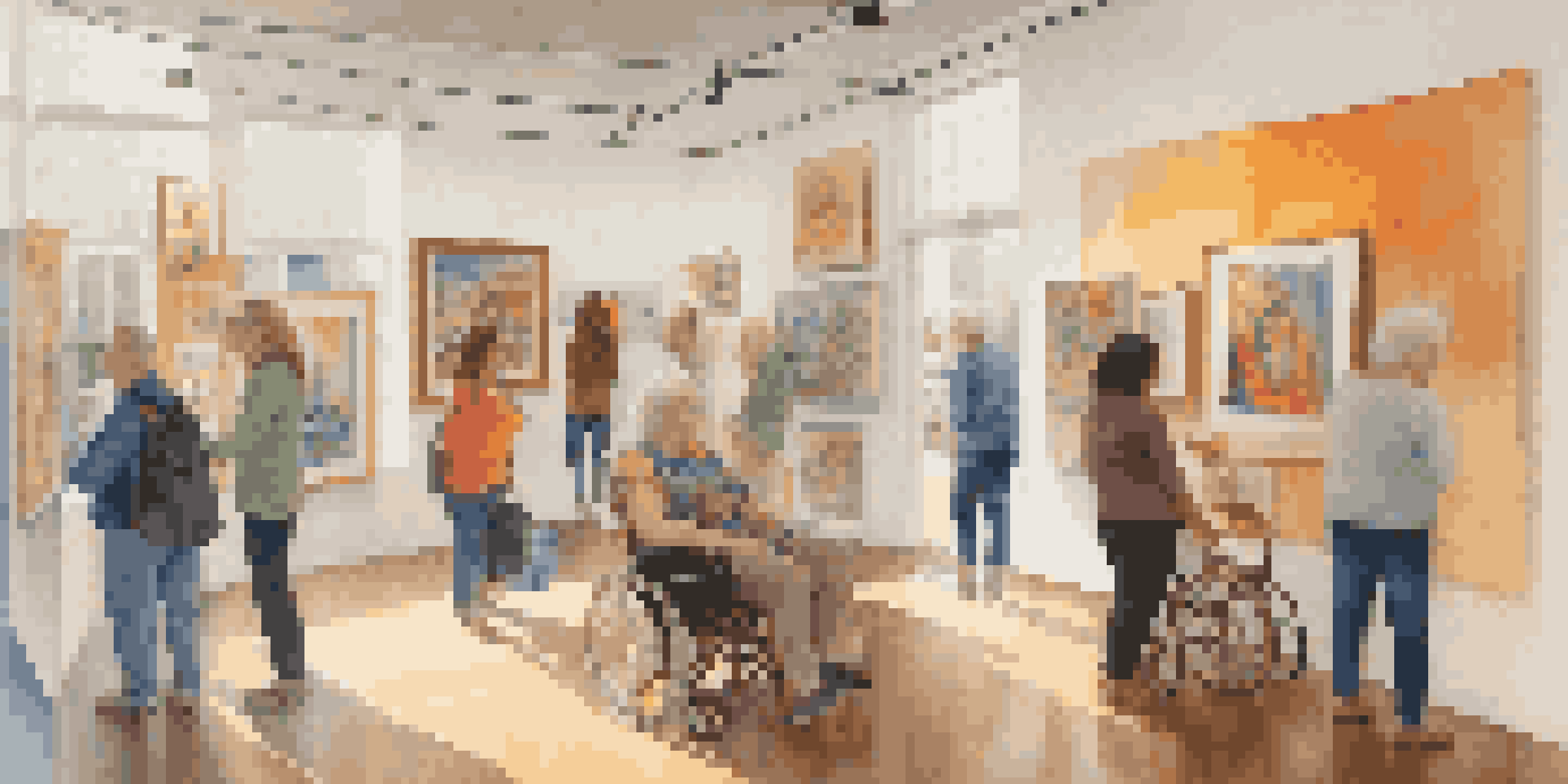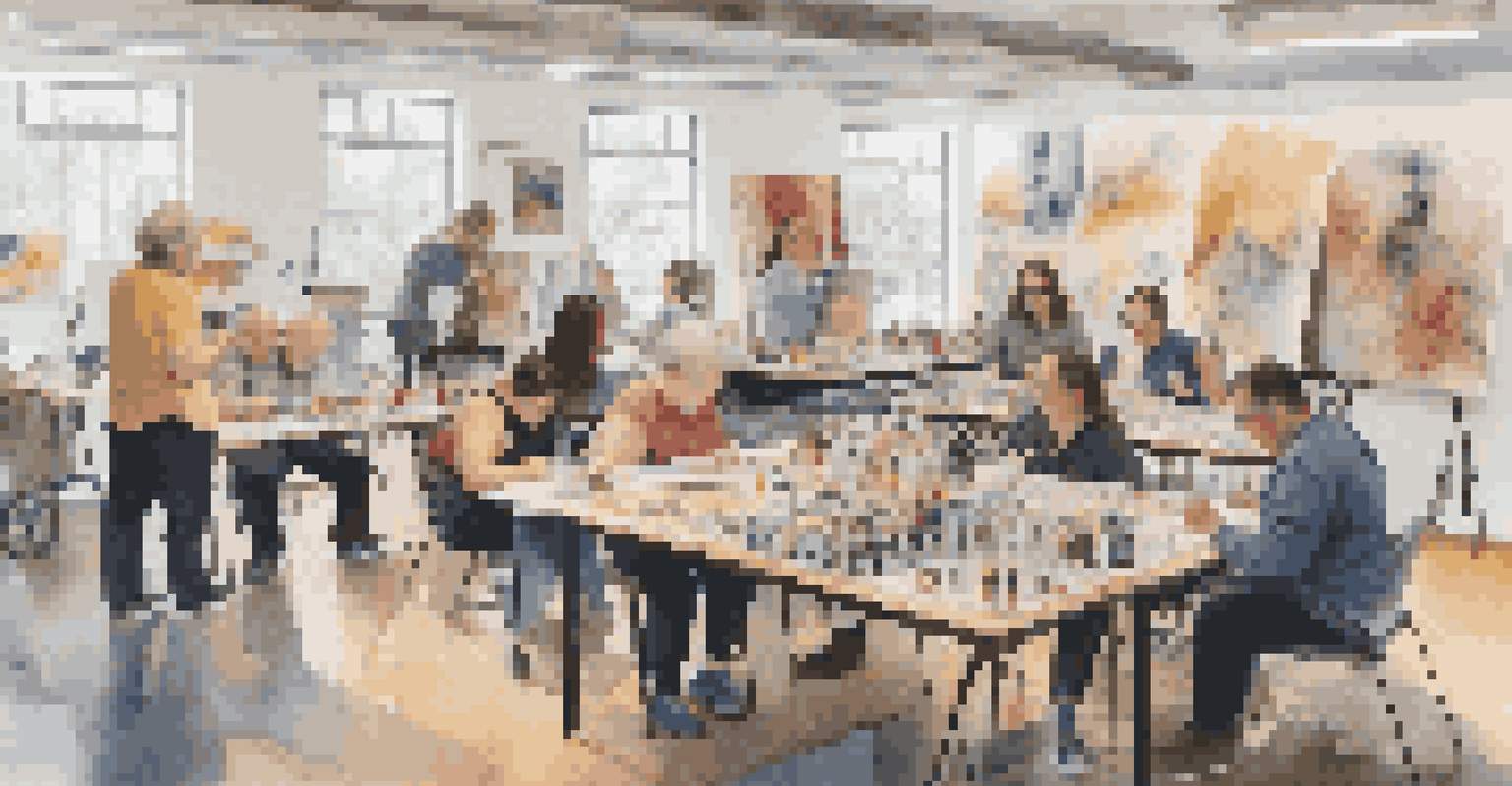Art Criticism and Disability: Analyzing Representation

Understanding Art Criticism in the Context of Disability
Art criticism typically involves evaluating and interpreting artworks, yet it often overlooks the nuanced experiences of disabled artists. This gap in understanding can lead to a narrow view of what constitutes valuable art. By integrating perspectives from the disability community, we can enrich art criticism and appreciate diverse expressions of creativity.
Art is not what you see, but what you make others see.
Critics play a crucial role in shaping public perception, so it's essential for them to consider how disability is represented in their analyses. When critics challenge traditional narratives, they open doors to broader discussions about inclusivity and representation in art. This shift not only benefits artists with disabilities but also enriches the cultural landscape for everyone.
Moreover, engaging with disability in art criticism allows for a more comprehensive understanding of the human experience. It encourages critics to ask deeper questions about identity and representation, ultimately fostering a more inclusive art world. By acknowledging these perspectives, we pave the way for authentic dialogues about art's role in society.
The Historical Context of Disability in Art
Historically, disabled individuals have often been marginalized in the art world. Many artworks depict disability in a stereotypical or pitying light, failing to represent the true complexity of disabled lives. Recognizing this bias is crucial for evolving our understanding of art as a reflection of society.

By examining past representations of disability in art, we can identify patterns of exclusion and misrepresentation. For example, works from various art movements have often romanticized or demonized disability rather than depicting it with authenticity. Acknowledging these historical inaccuracies helps us understand current challenges in art criticism and representation.
Importance of Disability Perspectives
Incorporating the experiences of disabled artists enriches art criticism and promotes a more inclusive understanding of creativity.
This historical lens not only sheds light on the ongoing struggles faced by disabled artists but also highlights their resilience and contributions to art. By giving voice to these narratives, we can shift the conversation toward a more inclusive appreciation of art. This evolution is essential for creating a more equitable art landscape.
Contemporary Disabled Artists and Their Impact
Today, many disabled artists are making waves in the art world, challenging stereotypes and redefining representation. Their work often reflects personal experiences and societal commentary, inviting audiences to reconsider preconceived notions about disability. This shift has prompted critics to reevaluate how they approach art by disabled creators.
The artist is a creator of beautiful things. To reveal art and conceal the artist is art's aim.
For instance, artists like Judith Scott and Chuck Close have transformed their disabilities into powerful statements that resonate with broader themes of identity and resilience. By focusing on their unique perspectives, these artists invite viewers to engage with art on a deeper level. Their contributions are reshaping the narrative around disability in the art world.
Moreover, the success of these artists encourages emerging talents to express their own stories through art. As more disabled voices gain recognition, the art world becomes richer and more diverse. This ongoing transformation is vital for fostering a culture of inclusivity and understanding.
The Role of Art Critics in Promoting Disability Awareness
Art critics have a significant responsibility in shaping narratives around disability in art. By thoughtfully analyzing works from disabled artists, critics can amplify their voices and experiences. This not only enhances the visibility of disabled creators but also educates audiences about the importance of representation.
A critical approach that considers the context of artists’ disabilities can lead to more meaningful interpretations of their work. Critics who prioritize inclusivity contribute to a more nuanced understanding of art as a medium for expression and communication. This shift can inspire other critics to follow suit, fostering an environment of empathy and respect.
Art Critics' Role in Representation
Critics have the responsibility to analyze and amplify the voices of disabled artists, fostering visibility and understanding within the art community.
Furthermore, by addressing the systemic barriers faced by disabled artists, critics can advocate for change within the art community. This advocacy can take many forms, including promoting equitable access to galleries and exhibitions. By leading these conversations, critics help pave the way for a more inclusive future in the art world.
Challenges in Art Criticism and Disability Representation
Despite advancements, significant challenges remain in the representation of disability in art criticism. Many critics still lack the knowledge or sensitivity required to engage with disability issues meaningfully. This gap can lead to misinterpretations and reinforce harmful stereotypes, detracting from the artists’ intended messages.
Additionally, the art world can be inaccessible to many disabled artists, limiting their opportunities for exposure. This systemic issue complicates the relationship between artists and critics, as not all voices are equally represented. Critics must recognize these barriers and strive to include a wider range of perspectives in their analyses.
To address these challenges, ongoing education and dialogue within the art community are essential. Critics should actively seek out resources and engage with disabled artists to better understand their experiences. This commitment to learning can foster a more inclusive art criticism landscape that truly reflects the diversity of human expression.
Future Directions for Art Criticism and Disability
As we look to the future, the intersection of art criticism and disability presents exciting opportunities for growth and transformation. Emerging technologies and platforms are making it easier for disabled artists to share their work and connect with audiences. Critics must adapt to these changes and embrace new ways of engaging with art and its creators.
Furthermore, collaboration between disabled artists and critics can lead to innovative approaches to art criticism that prioritize inclusivity. By working together, they can create a dialogue that amplifies voices often overlooked in traditional critiques. This partnership has the potential to reshape the art landscape for the better.
Challenges in Disability Representation
Despite progress, barriers remain in the representation of disabled artists, necessitating ongoing education and advocacy within the art world.
Ultimately, fostering a culture of inclusivity in art criticism will benefit everyone. By embracing diverse perspectives, we enrich our understanding of art and its impact on society. As we move forward, let’s commit to creating a more equitable and representative art world for all.
Conclusion: Embracing Diverse Perspectives in Art
In conclusion, art criticism and disability representation are intricately linked in shaping our understanding of art. By acknowledging the importance of diverse perspectives, we can create a more inclusive art landscape. This awareness is essential not only for disabled artists but for the art community as a whole.
As we continue to challenge traditional narratives, we pave the way for richer discussions about identity, creativity, and representation. The role of critics is pivotal in this journey, as they hold the power to shape public perception and advocate for change. By embracing inclusivity, we can foster a culture that values all voices.

Ultimately, the goal is to create a space where everyone can appreciate and engage with art, regardless of their background or abilities. As we move forward, let’s strive to champion the stories of disabled artists and celebrate the beauty of diverse expressions in art.